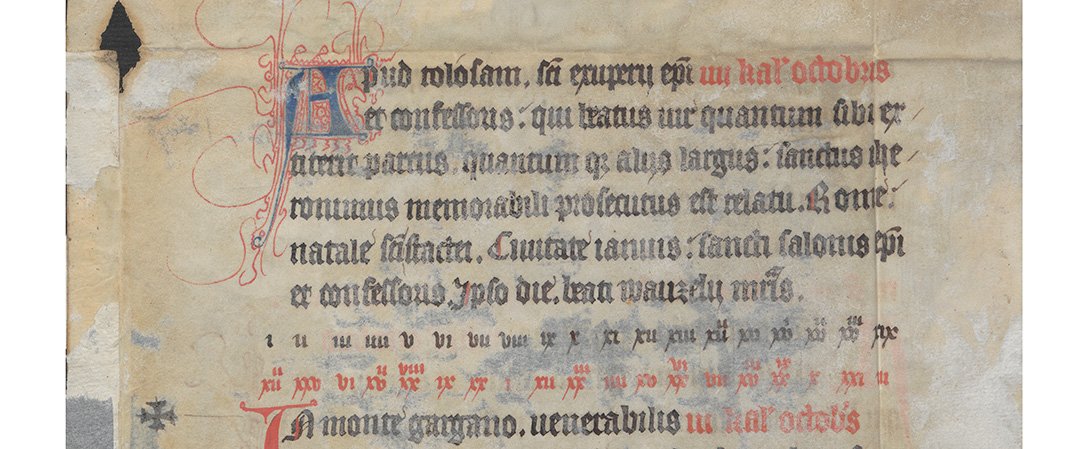Martyrologium cisterciense (fragments)
Oh, to be a martyr …
You are being thrown into the sea with a stone around your neck, or beaten to death with sticks and swords; thrown into the fire, and if that does not do the trick, crucified, thrown to the lions, or flung from the window into a pit… Becoming a martyr is not the easiest of tasks. A lot of pain and violence was involved, but if you stuck to your faith, a fine reward awaited you: canonization, a place in heaven, and for hundreds of years your sacrifices would be kept on record in martyrologies. Such catalogues of martyrs can ‘commemorate’ other information as well …
Martyr in agony
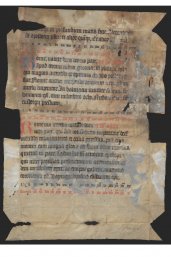
The word martyr comes from the Greek mártys ‘ witness’, and in a Christian context means someone who dies because he or she testifies to the Christian faith. In the days when Christians were prosecuted in the Roman Empire, physical agony was usually part of the process: you were tortured or met your violent death in another way. The first martyr was Stephanus (St. Stephen) whose stoning by the Jews is recorded in the Acts of the Apostles 6:8-8:2. His name literally means ‘Crown’, that is why in the texts it is said that somebody is ‘crowned’ with martyrdom. Perhaps the most well-known martyr is the arrow-riddled Sebastian whose picture has been painted by many famous artists.
Diehards
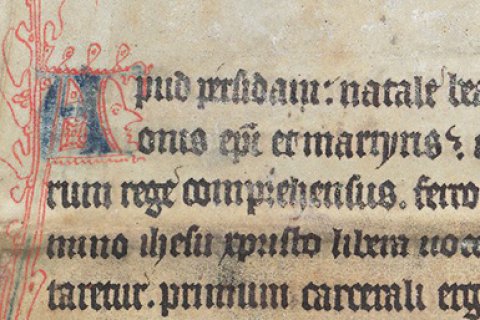
Several martyrs were real diehards. The brothers Cosmas and Damianus were victims of the prosecutions during the reign of Emperor Diocleatanius (in 303). However, they survived torture, chains and dungeons and stayed miraculously alive after having been dumped into the sea. Also being burnt at the stake did not do much to help, so on 27 September they were nailed to the cross, stoned, riddled with arrows and finally decapitated. Two other martyrs, Martianus and Satirianus, were bludgeoned, as were their two brothers, and pierced to the bones, but each night their wounds would heal, so the whole treatment had to be resumed each morning. On 16 October, with their feet tied by a rope to a four-in-hand, the brothers were dragged through thorn-bushes. These measures finally proved to be adequate.
Martyrologies
Such stories are collected in martyrologies. Each day is dedicated to martyrs who died for their faith on that particular date, most of whom during the prosecutions under the Roman emperors. The entries are brief, because the suffering of most martyrs was already recorded in more extensive passion tales or other stories about their fate. Churches and monasteries could be dedicated to martyrs, and this often went hand in hand with the (alleged) possession of a relic of the martyr in question, varying from remnant of a finger to a complete collection of bones.
Order
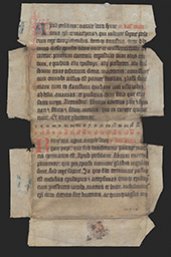
Because of the local devotion to certain martyrs, many regional differences arose in early Christianity between feast-days associated with specific martyrs. Some martyrs were even commemorated on several dates. To create order in the variety of commemorations which became widely used in several regions, ‘universal’ martyrologies were compiled, such as the Martyrologium Hieronymianum. In the second half of the 9th century Usuardus compiled a martyrology which turned out to be very influential. When in the Abbey of Cîteaux (near Dijon) the Cistercian order was founded in 1098, the need arose for a martyriology especially for that order. Usuardus’ martyrology was used as its basis.
Five separate leaves
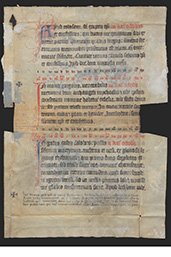
Utrecht University Library houses a version of the Cistercian martyriology. That is to say, five leaves of it. The original manuscript from the 13th century was once used to bind five books from the 18th century. Together they cover, completely or partly, 10-14 and 19-22 April, 23-26 and 26-30 September (continuously) and 13-17 October.
Notes in the margin
There are dozens if not hundreds of medieval martyriologies of the Cistercian order, and textually the five leaves are not that remarkable. When a group of six students transcribed the fragments for a course, they made an amazing discovery. In the margin of one of the leaves a text could be read which shed light on the exceptional origin of the original manuscript. At 29 September it says :

(in translation):
'By divine grace is here (on this day) the beginning of the founding of the Abbey of Herkenrode of the Cistercian order. In the year of Our Lord 1192, during the emperorship of Henry (and) during the reign of Albert, bishop of Liège. To the good memory of the most pious count Gerard van Loon, Lord Protector of the same place (Herkenrode) who died on the fourth Nonae of November (2 November). May his soul rest in peace'.
Origin from Herkenrode
The Cistercian convent Herkenrode is situated near Hasselt in Belgian Limburg. Until the discovery of the students only three manuscripts from this convent were known, from 1423, ca. 1525 and 1544. However, the fragments can be dated back to the second half of the 13th century, and so are the oldest known manuscript fragments from this convent. And there is more: it is the only source revealing the founding day of the convent, 29 September, and is the oldest source for the founding date of 1192 whereas in some later sources only 1182 is mentioned. Also the dying day of Gerard van Loon was never known. In this way the fragments are remarkable after all.
Analysis
The transcription and analysis by students Bastiaan Uijttewaal, Marisa Mol, Erin Vrijer, Julia Franken, Matthea Blok and Marianna Kersten, as edited by Bart Jaski and Sigrid Lussenburg, can be downloaded here. The article gives also more information about the fragments, their origin and the notes in the margin. It is fitting that via a note in the Herkenrode martyrology, the memory and the commemoration of the founding and its founder can now still be kept alive.
Author: Bart Jaski, December 2013
